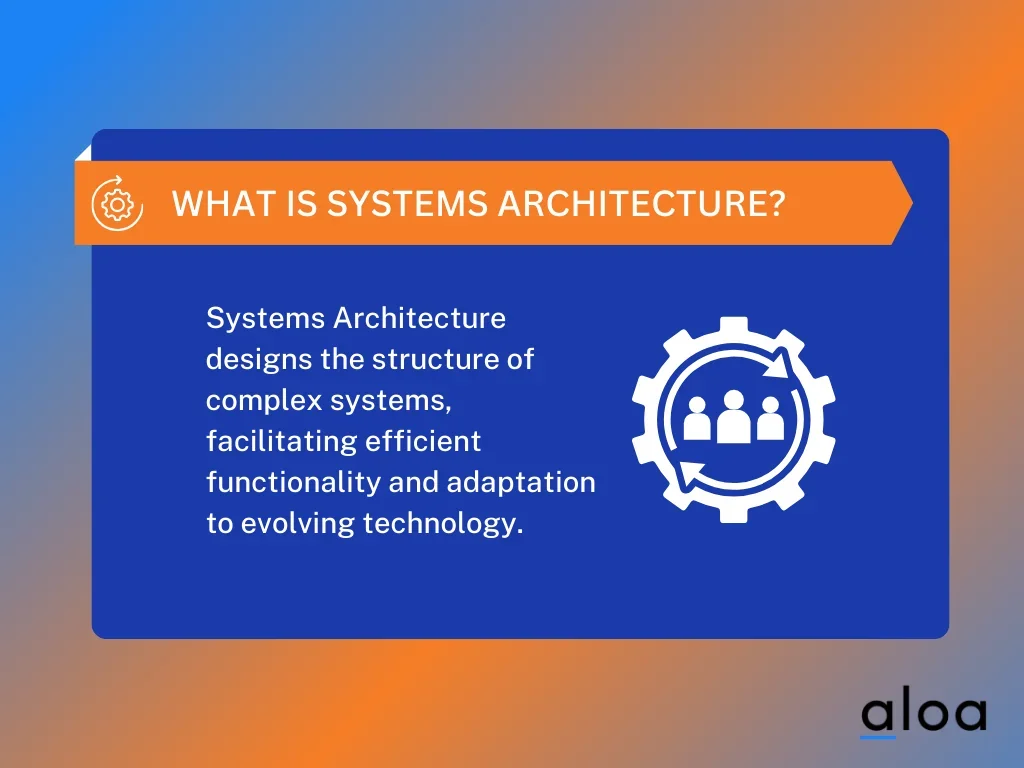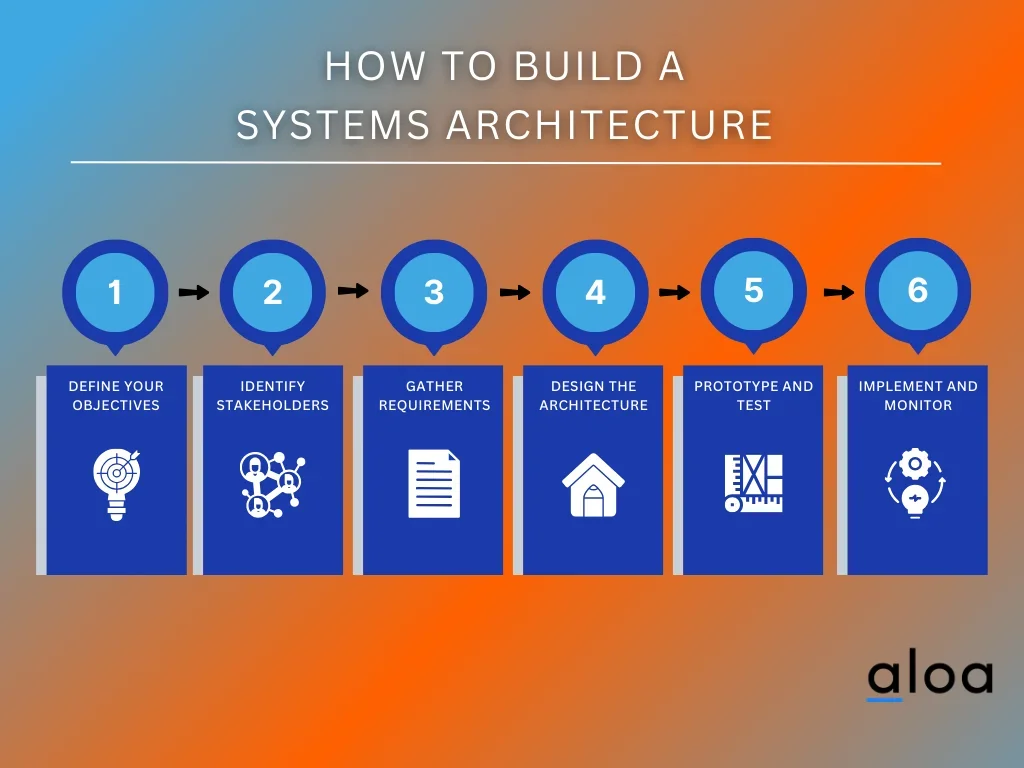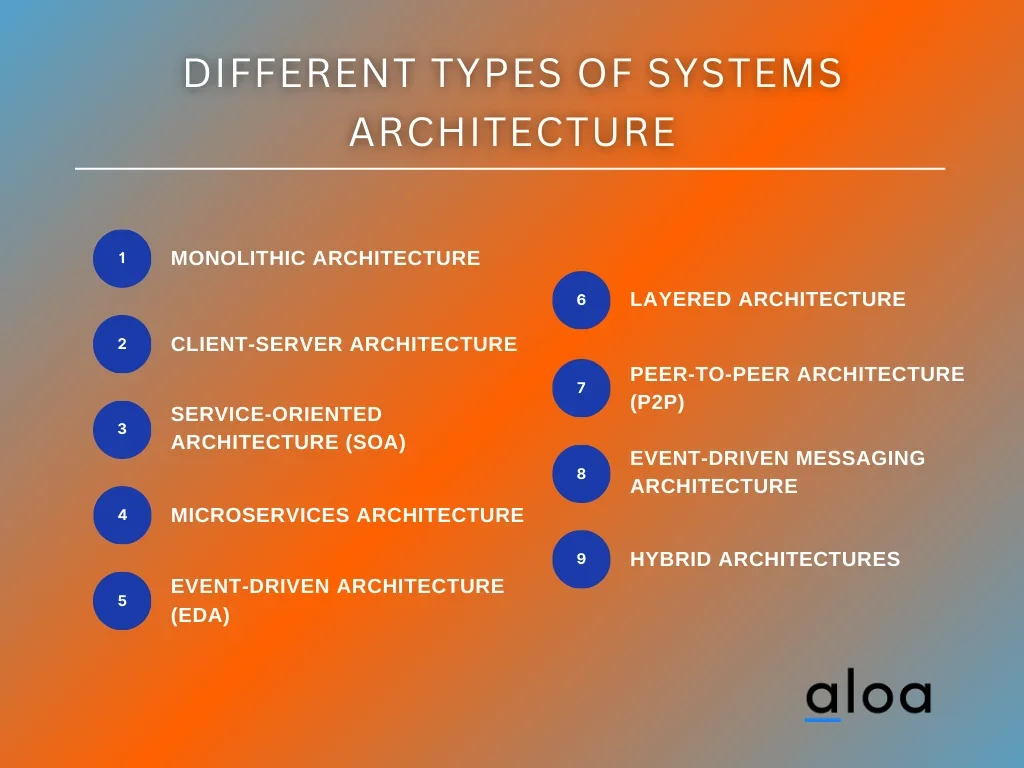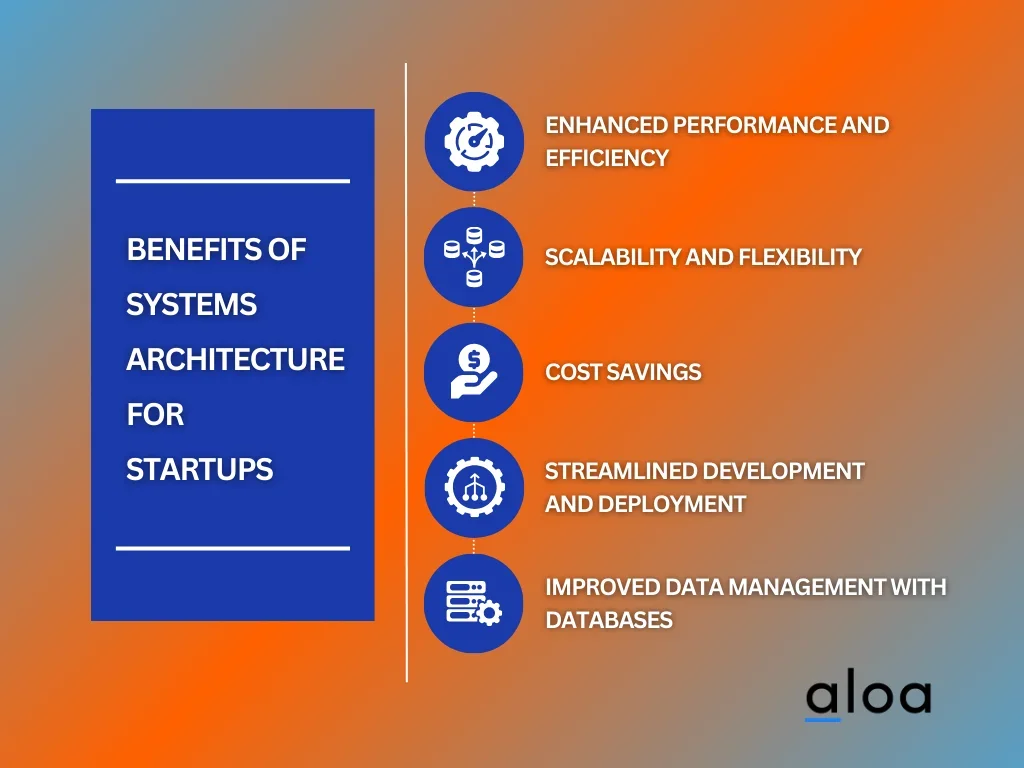Systems architecture is crucial for startups, businesses, companies, and software developers. It lays the foundation for designing, developing, and implementing complex systems to ensure it meets specific tasks and customer requirements. However, startups often face challenges in systems architecture due to limited budgets, scalability issues, rapid expansion, and ever-changing technology landscapes.
Aloa, with its extensive industry experience and expertise in system architecture, helps businesses and startups navigate these challenges effectively. Whether it's the architecture of a system, software architecture, or the integration of different components, Aloa provides valuable insights and solutions to drive businesses forward.
This blog will explore systems architecture, its essential components, and its different types. We will discuss the benefits of leveraging this architecture in modern systems. Afterward, you will understand how system architecture impacts software development, business logic, and overall system performance.
Let's jump in!
What is Systems Architecture?

Systems Architecture is a fundamental concept in technology and engineering that refers to the high-level design and structure of complex systems. It serves as a blueprint or framework that defines how various components, subsystems, and modules within a system interact with each other to achieve specific objectives.
One key aspect of software architecture is layered architecture, which helps create a conceptual model for system development. This approach breaks down the system into manageable subsystems, each with specific functionality and responsibilities. These subsystems communicate with each other, aligning the entire system to perform its intended tasks.
Systems architecture is the backbone of any software or enterprise architecture, enabling the efficient functioning of the entire system while accommodating the ever-evolving technology landscape.
Key Components of Systems Architecture
In systems architecture, it's crucial to understand the key components that form the backbone of any efficient and well-structured system. Let's explore ten essential components that define the landscape of software architecture.

- Hardware Infrastructure: The physical machinery, servers, and equipment that support the system's operations.
- Software Stack: A set of software layers that includes the operating system, middleware, and application software.
- Network Configuration: The arrangement of network components, such as routers, switches, and firewalls, ensuring seamless communication.
- Data Storage: The place where data is stored, whether in relational or non-relational databases.
- Web User Interface (UI): Web UI is the user-facing part of the system where users interact with the application.
- Security Measures: Strategies and tools implemented to safeguard the system from threats and breaches.
- Scalability Solutions: Mechanisms for adapting the system to handle increased loads and traffic.
- Integration Protocols: Standards and protocols integrate various system components seamlessly.
- Monitoring and Logging: Tools and practices to track system performance and identify issues.
- Backup and Recovery: Procedures and tools in place to ensure data backup and system recovery in case of failures.
How To Build a Systems Architecture
A robust systems architecture is critical for startups, businesses, companies, and software developers to ensure efficient and scalable operations. Let’s explore how to build a systems architecture supporting your organization's growth and development.

Step 1: Define Your Objectives
The first step in crafting a successful system design is clearly defining your objectives. Before diving into the intricate details of your system, it's essential to have a bird's-eye view of what you aim to achieve. These objectives will serve as your guiding light throughout the entire process.
When setting your objectives, consider your business goals and the specific challenges you intend to address with your new architecture. Are you aiming to improve the performance of your web application? Do you want to enhance data security and compliance? Or you're focused on optimizing resource utilization and scalability.
Whatever the goals may be, understanding them is crucial. Systems architecture is the foundation upon which the entire system is built. It defines the system's boundaries, components, data flow, and communication channels, making it a crucial aspect of any technology-driven endeavor.
Step 2: Identify Stakeholders
Identifying the key stakeholders involved in your project is the next critical step. Stakeholders are individuals or teams with a vested interest in the outcome of your software architecture. They can include executives, product managers, developers, and IT operations teams. Engaging with these stakeholders ensures that everyone's needs and expectations are considered.
By involving stakeholders from the beginning, you gain valuable insights into their requirements and concerns. This collaborative approach helps align the architecture with the organization's overall objectives. Moreover, it promotes a sense of ownership and commitment among team members, which is crucial for successfully executing your architectural plan.
Step 3: Gather Requirements
Once your objectives and stakeholders are defined, the next step is gathering detailed software architecture requirements. Requirements gathering involves a comprehensive analysis of what your system needs to achieve. This analysis covers various aspects, including:
- Functionality: What specific features and capabilities should the system have?
- Performance: What level of performance and responsiveness is required?
- Scalability: How should the architecture accommodate growth and increased user demand?
- Security: What measures are necessary to protect sensitive data and ensure compliance?
Accurate and thorough requirements gathering is essential to ensure your architecture meets your organization's and its users' needs. It serves as the foundation for all subsequent design and implementation decisions.
Step 4: Design the Architecture
With a clear understanding of your objectives and requirements, you can move on to the design phase. System Architecture design involves creating a blueprint for your system. This blueprint defines the components, their interactions, and the technology stack to be used.
Consider the following factors during the design process:
- Data Storage: Determine how and where data will be stored in a relational or non-relational database.
- Communication Protocols: Define how different components of your system will communicate with each other and external services.
- Security Measures: Plan for security from the ground up, including encryption, authentication, and access control.
The design phase should result in a comprehensive architectural diagram visually representing your system's structure and components. It should also provide clear guidelines for implementation. Using software documentation tools at this stage helps keep diagrams, decisions, and system details organized and easy to update as the design changes.
Step 5: Prototype and Test
Before implementing your architecture at scale, creating prototypes and conducting thorough testing is essential. Prototyping allows you to validate your design concepts and uncover potential issues early. Meanwhile, testing ensures that your architecture can handle real-world scenarios and performance demands.
During the prototyping phase, you can create smaller-scale versions of your system's components to validate their functionality and interactions. This iterative approach allows you to refine your design based on practical insights and user feedback.
On the other hand, testing involves various types of assessments, including functional testing, load testing, and security testing. These tests help identify and mitigate potential vulnerabilities and performance bottlenecks. Regular testing cycles ensure that your architecture remains robust and resilient.
Step 6: Implement and Monitor
Once your architecture has been thoroughly tested and refined, it's time for implementation. During this phase, you'll build and deploy the components according to your design. Whether you're working with a monolithic system or a distributed microservices architecture, careful execution is essential.
Continuous monitoring is crucial after implementation. You must keep a watchful eye on the performance, security, and scalability of your system. Use monitoring tools and metrics to identify any issues or areas for improvement.
Regular updates and maintenance are also part of the implementation phase. As your organization evolves, your architecture may need adjustments to meet changing requirements. Be prepared to adapt and refine your system to align with your objectives.
Different Types of Systems Architecture
Understanding the different systems architecture types is crucial for startups, businesses, companies, and software developers to make informed decisions about their technology infrastructure. Let's explore the key types of systems architecture and their unique characteristics.

Monolithic Architecture
Monolithic architecture is one of the oldest and simplest forms of software architecture. This approach builds an entire application as a single, self-contained unit. All the components, modules, and functionalities are tightly integrated into a single codebase. While this architecture is straightforward, it can be challenging to scale and maintain as the application grows. Changes or updates to one part of the system often require modifications to the entire monolith.
Client-Server Architecture
Client-Server architecture is a widely used model in which the system is divided into two main components: the client and the server. While servers handle data processing and storage, clients are responsible for the user interface and user experience. This architecture allows for more effortless scalability and maintenance compared to monolithic systems. Web applications, for example, often follow a client-server model where web browsers (clients) communicate with web servers to fetch and display content.
Service-Oriented Architecture (SOA)
Service-Oriented Architecture (SOA) is an architectural approach that focuses on breaking down applications into smaller, reusable services. These services can be independently developed, deployed, and maintained. SOA promotes flexibility and reusability, making it suitable for large, complex systems where various components must communicate seamlessly. It is often associated with web services and APIs to facilitate communication between services.
Microservices Architecture
Microservices architecture takes the concept of service-oriented architecture a step further by decomposing an application into even smaller, specialized services known as microservices. Each microservice is responsible for a specific function and can be developed and deployed independently. This approach offers significant advantages in scalability, agility, and fault tolerance. Microservices have gained popularity in modern software development, particularly in cloud-native applications. To effectively manage the interactions between these independent services, a microservices API gateway is often implemented. This gateway serves as a critical component, routing requests and facilitating communication among the services, enhancing scalability, agility, and fault tolerance.
Event-Driven Architecture (EDA)
Event-Driven Architecture (EDA) is centered around events and messages. Different components or services in this architecture communicate by emitting and consuming events. This decoupled approach allows for real-time responsiveness and adaptability. EDA is commonly used in scenarios where systems need to react quickly to changing conditions, such as financial trading platforms or IoT applications.
Layered Architecture
Layered architecture is a modular approach that divides an application into distinct layers, each responsible for a specific functionality aspect. Common layers include presentation, business logic, and data access. This architecture promotes separation of concerns and maintainability. It is often seen in traditional desktop applications and enterprise software.
Peer-to-Peer Architecture (P2P)
Peer-to-Peer architecture is a decentralized model where each node in the network has equal status and can communicate directly with other nodes. P2P networks are often used for file sharing and decentralized applications. They eliminate the need for central servers and can be highly resilient.
Event-Driven Messaging Architecture
Event-Driven Messaging Architecture is an approach that emphasizes the use of messaging systems to facilitate communication between components or services. Messages are used to transmit data and trigger actions. This architecture is beneficial for building asynchronous and distributed systems.
Hybrid Architectures
Hybrid architectures combine elements of two or more of the architectures above to meet specific requirements. For example, a hybrid approach might integrate microservices with a client-server model or combine SOA with event-driven messaging. Hybrid architectures offer flexibility and customization to address complex business needs.
Benefits of Systems Architecture for Startups
Systems architecture plays a pivotal role in shaping the success of businesses and startups in today's tech-driven world. Its significance lies in its ability to provide a robust framework for designing, implementing, and managing complex systems.
Let's explore five key benefits of systems architecture for businesses and startups, shedding light on how it can drive efficiency, scalability, and competitiveness.

Enhanced Performance and Efficiency
Systems architecture optimizes the overall performance of a system by carefully orchestrating its components. By designing systems with efficiency in mind, businesses can ensure that their applications and processes run smoothly. This translates into faster response times, reduced downtime, and improved customer satisfaction. Whether it's a web-based application or an internal inventory management system, optimized performance can be a game-changer for businesses aiming to outperform their competitors.
Scalability and Flexibility
One of the primary advantages of software architecture is its ability to scale with the growing demands of a business. Startups, in particular, benefit from this as they aim to expand rapidly. A well-designed architecture allows for seamless scalability, whether handling increased user traffic, accommodating new features, or adapting to changing market conditions. This adaptability ensures that businesses and startups remain agile and respond to market dynamics effectively.
Cost Savings
Systems architecture can lead to significant cost savings in the long run. Businesses can reduce operational expenses by optimizing resource utilization and ensuring efficient workflows. For startups working with limited budgets, cost-effective solutions are crucial. Software architecture allows allocating resources based on actual needs, eliminating unnecessary expenditures on hardware or cloud services.
Streamlined Development and Deployment
Efficient systems architecture streamlines the development and deployment processes. It enables teams to work cohesively, leading to faster development cycles and quicker time-to-market. For startups, this means getting their innovative solutions in front of customers sooner, gaining a competitive edge. Furthermore, maintenance becomes more straightforward with a well-defined architecture, reducing the likelihood of critical system failures.
Improved Data Management with Databases
A crucial aspect of system architecture is a database. Businesses, especially those dealing with extensive data, must choose between relational and non-relational databases. Relational databases, such as MySQL and PostgreSQL, offer structured data storage suitable for applications with complex relationships. On the other hand, non-relational databases like MongoDB and Cassandra excel at handling unstructured or semi-structured data, providing greater flexibility. The choice depends on the business's specific needs, and a well-designed software architecture can seamlessly integrate the preferred database solution.
Key Takeaway
Effective systems architecture empowers startups by providing a structured framework for their software and hardware systems. It ensures the technology stack aligns with the company's goals and objectives. This alignment translates into improved performance, scalability, and cost-efficiency. Startups benefit from software architecture by streamlining their development and deployment processes, resulting in faster time-to-market and cost savings.
However, implementing systems architecture has its challenges. It requires careful planning, expertise, and continuous adaptation to evolving technologies. Choosing the right architecture type, managing complexity, and ensuring security are hurdles that must be overcome. The key to success lies in finding the right balance between structure and flexibility, leveraging the advantages of different architecture types, and prioritizing scalability and reliability.
To stay ahead, sign up for our email list and get the latest news in startups and tech. For inquiries, contact us at [email protected]. Embrace effective systems architecture and pave the way for your organization's success.

